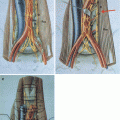Treatment
Alla
LVI +
LVI −
Surveillanceb
BEP × 1c
Surveillanceb
BEP × 1c
Surveillanceb
BEP × 1c
Number of patients
1,000
1,000
1,000
1,000
1,000
1,000
Relapses
250
21
500
32
150
16
Total number of chemotherapy courses given
735
1,030
1,470
1,072
441
1,012
Patients exposed to salvage therapy, i.e. ≥ 3 courses of chemotherapy
245 (24.5 %)
10 (1 %)
490 (49 %)
23 (2.3 %)
147 (14.7 %)
4 (0.4 %)
3.4 Discussion
Both surveillance and adjuvant BEP result in short-term survival rates close to 100 %. Today, the aim of the treatment in these patients is to minimize the risk of long-term toxicity. The data on one course of adjuvant BEP is now solid and mature with long-term results on over 700 patients reported. Two courses of adjuvant BEP now represent overtreatment in CSI nonseminoma and should no longer be used.
Salvage treatment is associated with serious long-term toxicity such as cardiovascular disease and secondary cancers as well as pulmonary toxicity, nephrotoxicity, neurotoxicity, hypogonadism, infertility, ototoxicity and psychological sequelae [8]. Short adjuvant chemotherapy seems not to increase the risk of neurotoxicity, infertility, hypogonadism or cognition. Data on the risk of secondary cancers and cardiovascular disease is still lacking. Until data is presented, one must assume that one course of adjuvant may increase the risk of serious late toxicities. However, the risk of long-term toxicity is highly dose dependant [8], indicating that an increased risk will be small.
Stay updated, free articles. Join our Telegram channel

Full access? Get Clinical Tree






